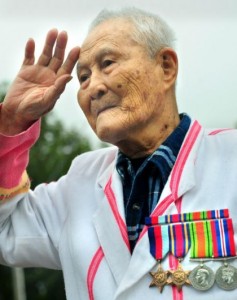Refugee marches on Anzac Day
 Among the dozens of defence veterans who marched on Anzac Day in Werribee this week was one distinctive face.
Among the dozens of defence veterans who marched on Anzac Day in Werribee this week was one distinctive face.
Bordy Weeku is a 94-year-old Karen refugee who fought with the British Army against the Japanese in Burma during WWII.
He joined the army in 1937 at just 18 years of age and trained as a soldier in India.
After war Mr Weeku worked as a clerk in the Burmese education department but as tensions between the Burmese and Karen people flared in the 1970s and 1980s, he was forced to flee his homeland.
He spent 20 years in the Mae La refugee camp on the Thai-Burma border living behind barbed wire and existing on meagre rations.
The camp was established in 1984 in the Tak Province area and currently houses 50,000 with more arriving each week from Burma. Mae La is the largest refugee camp for Burmese in Thailand and more than 90 per cent of its inhabitants are ethnic Karen. It has been attacked several times by the Burmese army.
Mr Weeku arrived in Australia as a refugee and a client of AMES in 2007 and is now the oldest and most respected member of Werribee’s large Karen community.
His son Ehstoo Saw says Mr Weeku is proud to have served in the war and is now enjoying his retirement in Werribee.
“He marched on Anzac Day in Werribee wearing his medals and he was proud to be with the other veterans,” he said.
Mr Weeku still has a son living in Mae La camp and a daughter living inside Burma.
During the war, British forces preparing for the Japanese invasion of Burma enlisted the services of Karen tribesmen who were loyal to The Crown.
Under colonial rule some Burmese, including the Burma Independence Army, saw the British as imperialist oppressors and hoped the Japanese would defeat the British and give them independence. But under the British, the Karen were guaranteed some autonomy.
When war broke out there were already many Karen serving with the British forces and they were asked to recruit more men to join the fight.
With the Japanese invasion of Burma in 1942, many of the Karen fighters – known as Levies – retreated to India with the British. The Japanese and the Burma Independence Army slaughtered many of their wives and children.
The Karen are the second largest ethnic group in Burma. In return for agreeing to fight alongside the British, they were promised an independent state; a homeland of their own within Burma.
They remained loyal to the British forces throughout the occupation and the Japanese were finally driven out in 1945.
But when the British pulled out of Burma shortly after the end of the war, the majority ethnic group, the Burmans assumed central power. They were opposed to a Karen state and a 60-year civil war began.
This fighting between different tribal peoples has come to be called the ‘Father to Son War’ because of its longevity.
In the decades after WWII, many of the persecuted Karen people have been forced to flee their homes.
From eastern Burma there are around 500,000 people living in hiding within Karen state and there are two million migrant Burmese workers in Thailand and around 140,000 people living in the camps.












